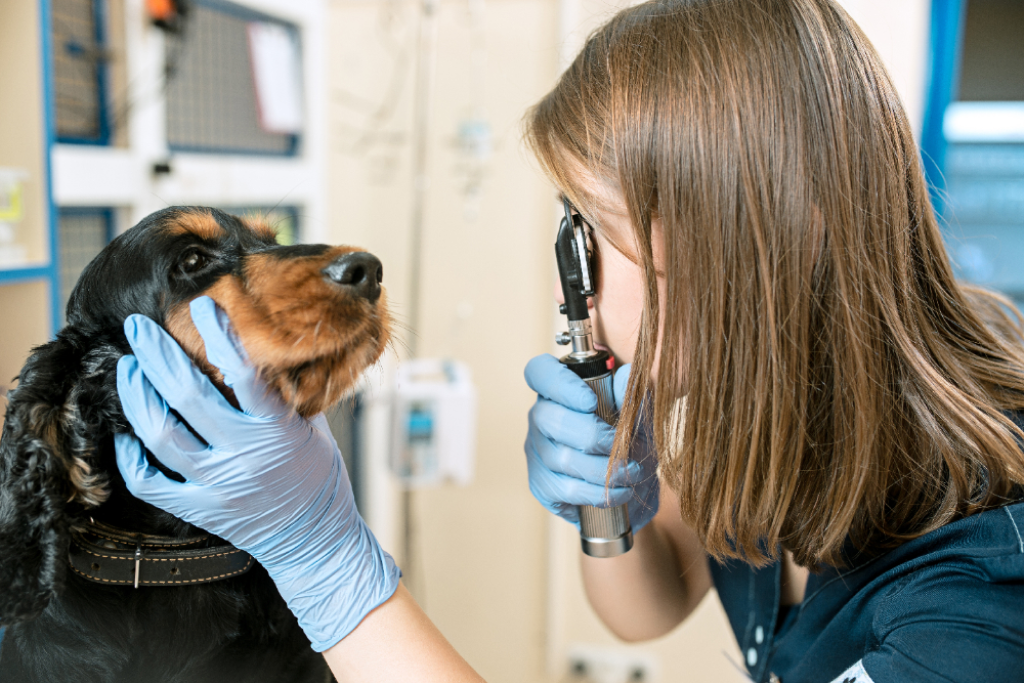Is your pet in pain?
Pain in pets often indicates an underlying health condition that you may not know they have, ranging from mild to much more severe, life-threatening conditions. As such, it is important to know and recognise the signs that your pet is in pain so that your vet can take the necessary steps to diagnose the problem, and begin treatment.
So, what are the signs that your pet is in pain?
Common signs that may indicate that your pet is in pain include changes in behaviour, changes to eating, sleeping, and drinking habits, being more vocal, heavy panting, mobility issues, and visible changes to their body.
Read on to learn more about pain in pets, including the common signs that your pet is in pain, and what might be the cause.
What are the Common Signs of Pain in Pets?
Often, pets are very good at hiding illness and, as such, it can be difficult to know when they’re in pain. However, there are a few common signs of pain that you can look out for, some more obvious than others.
Common Signs of Pain in Cats:
The signs of pain in different animals will vary from the above list slightly, by breed, and by individual circumstances. It might be useful to note that cats experiencing short-term pain are more likely to show signs of their pain or discomfort than those experiencing long-term or chronic pain. In these circumstances, cats can hide their pain for long periods of time
However, some common signs of pain in cats include:
- Reduced appetite
- Increased time spent sleeping
- Lethargy
- Changes in behaviour, e.g disinterest in things such as playing, social interaction, and exploring. They may also become withdrawn and avoid usual activities which now cause them pain, such as jumping and leaping
- Poor mood and temperament e.g. increased irritability or becoming aggressive when touched
- Appearing lame, including reduced motion and/or activity
- Increased sensitivity to touch in certain areas
- Decreased grooming, or overgrooming a particular area
If you spot any of these signs in your cat, do not try to diagnose or treat them yourself, as these symptoms could signify a number of different health problems, and you may make the problem worse. Instead, consult your vet as soon as possible.
Common Signs of Pain in Dogs:
The signs of pain and discomfort can vary greatly from dog to dog, depending on their experience, age, environment, and pain tolerance. Some dogs are more likely to show the signs of pain than others, which is why it is incredibly important to know what to watch out for. Some of the most common signs of pain in dogs include:
- Changes to eating behaviours, either increased or decreased
- Abnormal, or reduced movement, including loss of energy, unusual postures, limping, and restlessness
- Excessive grooming, which may indicate sores or surface wounds
- Vocalisation, e.g. unusual or excessive noises
- Aggression
- Reduced social interaction, e.g. a lack of interest in their favourite activities or toys. They may also seem tired or agitated.
If you notice any signs of pain in your dog, please contact your vet as soon as possible, and don’t try to diagnose or treat the condition yourself. Such signs can be indicators of a number of conditions, of which pain is just a symptom. Therefore, it is vital that your dog is checked by their vet as soon as possible.
Common Painful Conditions in Pets
Pain in pets can indicate a number of different conditions, some more severe than others. This is why it is crucial to consult your veterinarian as soon as you notice the signs of pain. Examples of common painful conditions in pets include:
Arthritis:
Arthritis is a very common, painful condition that causes stiff, swollen joints, and makes moving around very difficult for pets. It is a progressive condition and cannot be cured, however there are several treatments which can help to slow its progression and manage pain, including pain relief medication, joint supplements, hydrotherapy, and surgery.
Intervertebral Disc Disease/Slipped Disc:
Intervertebral Disc Disease (IVDD), also known as a slipped disc, is a condition that causes the intervertebral discs to lose their cushioning, become hard and more fragile, and slip out of place. When this happens, the slipped disc presses against the spinal cord, causing pain, nerve problems, and sometimes paralysis.
Treatment for IVDD depends on the severity of the condition. Mild IVDD will often be treated medically with pain relief, strict rest, and physiotherapy. However, more severe cases may require surgery.
Dental Pain:
Dental pain can indicate a number of different conditions, including tooth and gum disease in both cats and dogs. This is a painful disease that can also lead to other serious health problems, such as kidney and heart disease.
It is important to regularly inspect for symptoms, as most pets will continue to eat, despite the pain. Symptoms include bad breath, chewing on one side of the mouth, weight loss, red, inflamed, or bleeding gums, wobbly or broken teeth, excessive drooling, facial swelling, and blood-stained saliva.
Treatment for dental disease will depend on the specific problem, but may include anti-inflammatory medication, antibiotics, dental surgery, or the use of mouthwash.
Pancreatitis:
Pancreatitis is a condition in cats and dogs where the pancreas becomes inflamed. The condition can range from mild to severe, and is caused by the enzymes that the pancreas produces being activated too soon. Usually, they would activate as they reach the small intestine, but with pancreatitis, they activate prematurely and effectively begin to digest the pancreas.
The most common signs of pancreatitis include nausea and vomiting, fever, lethargy, abdominal pain, and a decreased appetite. It is important to know and recognise these signs as early diagnosis is crucial. For milder conditions, vets may recommend that pets rest and allow the body to heal itself. In more severe cases, pets may be hospitalised, tube fed, and pain relief and anti-inflammatory medications may be prescribed, alongside IV fluids to help restore normal function.
Cancer:
Unfortunately, pain in pets can sometimes be an indication of cancer. However, there are a number of other symptoms that may also indicate cancer, such as unexplained weight loss, abnormal bleeding, lumps and bumps, vomiting, diarrhoea, lameness, and coughing, amongst others.
As such, it’s best to not jump to conclusions, and to consult your vet for examination.
Skin Diseases:
Sometimes, skin infections or diseases can be somewhat painful for pets, but pain is usually not the only symptom. Typically, skin diseases and infections will also present with itchiness, irritation, flaky, crusty skin, redness, pustules, swelling, and a change in odour. They are usually fairly easy to spot, but can vary somewhat between species and breeds, and will also depend on age, health status, and any underlying conditions.
As such, treatment for skin diseases in pets will depend on the type of infection, the cause of the infection, severity, and other relevant conditions.
Diagnosis of Pain in Pets
Diagnosis of what is causing your pet pain can be difficult as causes of pain are many and varied. As such, various diagnostic tests are required to get to the root of the problem.
Your vet will first want to know a number of details, including where the pain seems to be presenting, as well as factors such as behavioural factors, visual changes, and changes in mobility. This will help to direct diagnostic tests.
They will then likely opt to conduct blood and urine tests and imaging such as X-Ray and ultrasound. They may also perform cytology and/or histology tests if necessary. Sometimes more advanced imaging such as MRI, and CT are also recommended to determine why the area is causing pain.
X-Ray:
X-Rays are quick, painless tests for cats and dogs that produce images of the internal structures of the body. They are typically used to diagnose bone fractures and breaks, arthritis and osteoarthritis, infections, and cancer, amongst other conditions. Your pet will need to sit still whilst the machine takes images, and may be moved into particular positions to produce better images.
Ultrasound:
Ultrasound is a common diagnostic tool for cats and dogs that uses high-frequency sound waves to produce images of organs and other structures within your pet’s body. The technician will press and move a small probe against the skin to capture real-time images. This is typically used to diagnose conditions related to soft tissue structures that are not easily seen on X-Rays. This can include the heart, the abdomen, and muscles.
Histology:
Histology is the study of tissues, usually collected via biopsy. Samples are prepared by preserving, thinly slicing or sectioning, and staining with dyes before being examined under the microscope by a pathologist. Histology is used in the same cases as cytology, but it provides a more accurate level of detail in order to make a definitive diagnosis.
CT:
A CT scan looks at various parts of the body, most commonly the bones, airways, and soft tissue structures. The test uses a continuous beam of X-Rays which spins around the body in a doughnut-shaped support to build up a cross-section of images.
Bloods and Urine Tests:
Blood and urine tests may be used to learn more about your pet’s health. Biochemistry, haematology, and inflammatory markers (CRP) are studied for signs of changes in their blood. These changes may help vets to determine a diagnosis, or understand more about your pet’s condition.
Blood tests are reasonably common, and there are many occasions in which your vet may decide to perform a blood test. When this happens, your vet will usually shave a small patch of fur, before inserting a needle into your pet, similar to when humans have blood taken.
Urinalysis is used to test the physical and chemical properties of the urine, mainly for the purposes of assessing the health of your pet’s kidneys and urinary system. However, it can also reveal issues in other organs and metabolic disease. There are multiple ways to collect urine samples from pets, including using a needle and syringe, through catheterisation, or collection mid-stream during free flow.
Cytology:
Cytology is the study of cell samples collected from your pet’s body. Vets use these samples to help diagnose growths or masses, but cytology can also be used to assess bodily fluids, internal organs, and abnormal fluids. Cytology sampling methods include skin scrapings, impression smears, swabs, and fine needle biopsies. Most cytology can be examined in-house at Knutsford Veterinary Surgery however on occasion where we need a specialist opinion we can have experts reports within an hour using Scopio.
MRI:
An MRI uses magnetic waves and radio waves to create a detailed image of the organs and tissues. Typically, MRI is used to detect problems with the brain and spinal cord, such as tumours, inflammation, and herniated discs. The test is performed under anaesthesia and will usually take between 45 minutes and 2 hours.
Common Treatments for Pain in Pets
There are a variety of treatments for cats and dogs in pain, but these largely depend on what is causing the pain, and the severity of the condition, as well as factors regarding your pet’s species, breed, age, and general health.
Common examples of treatments for pain include:
Medical Treatments
Sometimes, depending on the cause of the pain, your vet may prescribe medications to help manage the main. These can include:
-
- Nonsteroidal Anti-Inflammatory Drugs (NSAIDs) – NSAIDs interfere with the body’s production of inflammatory molecules that trigger pain and swelling.
- Paracetamol and codeine – a combined painkiller tackling inflammation and pain.
- Opioids – Opioids are typically prescribed for severe surgical pain, and may also be used in advanced cases of cancer or to control severe arthritis pain.
- Monoclonal Antibodies – a new treatment given as a monthly injection. It works by preventing Nerve Growth Factor from causing pain in arthritis
- Other pain relief medications include gabapentin, amantadine and amitriptyline
Non-Medical Treatments
For cases of chronic pain, non-medical treatments may be recommended by your vet to help manage pain. These may include:
- Supplements, such as joint supplements
- Physiotherapy
- Hydrotherapy
- Acupuncture
- Modifications to diet and/or exercise
How to Manage Your Pet’s Pain at Home
Once your vet has determined the cause of your pet’s pain, they will set out a suitable treatment plan that may include medical, non-medical, clinical, and at-home treatments. Examples of at-home treatments may include:
- Stay on top of any prescribed medications and appointments
- If changes to diet and/or exercise were recommended, ensure to carry out these changes – they were recommended for a reason
- Massage (if applicable)
- Create a soft, comfortable environment
- Follow their cues – if they seem to want company then show them some love, but if your pet prefers to hide away, let them do so, and allow them to come back out on their own terms (except to give medication, etc.)
At Knutsford Veterinary Surgery, we have a range of in-house diagnostic tools that can help us determine the cause of your pet’s pain quickly, so that we can get a head start on treatment. If your pet is showing signs of pain, get in touch with us as soon as possible, as for some conditions early diagnosis is crucial.
Our expert vets will examine your pet, carry out any necessary tests, and will work to provide you with answers as soon as possible, so that we can get started on helping your pet to feel better.





